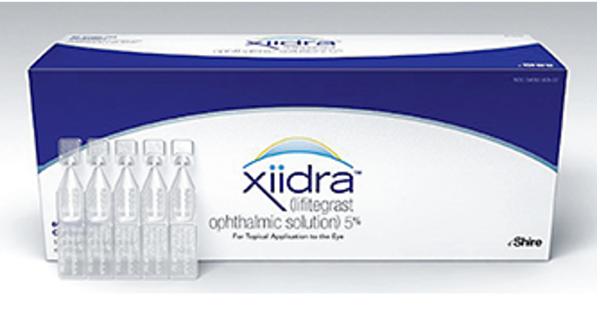Xiidra Side Effects
Generic name: lifitegrast ophthalmic
Note: This document provides detailed information about Xiidra Side Effects associated with lifitegrast ophthalmic. Some dosage forms listed on this page may not apply specifically to the brand name Xiidra.
Applies to lifitegrast ophthalmic: ophthalmic solution.
Precautions
Your eye doctor will want to examine your eyes at regular visits to make sure that this medicine is working properly and is not causing unwanted effects.
If your symptoms do not improve within a few days or if they become worse, check with your doctor.
Serious side effects of Xiidra
Along with its needed effects, lifitegrast ophthalmic (the active ingredient contained in Xiidra) may cause some unwanted effects. Although not all of these side effects may occur, if they do occur they may need medical attention.
Check with your doctor immediately if any of the following side effects occur while taking lifitegrast ophthalmic:
More common side effects
- changes in vision
- eye irritation or discomfort
Less common side effects
- blurred vision
- redness of the white part of the eyes or inside of the eyelids
Other side effects of Xiidra
Some side effects of lifitegrast ophthalmic may occur that usually do not need medical attention. These side effects may go away during treatment as your body adjusts to the medicine. Also, your health care professional may be able to tell you about ways to prevent or reduce some of these side effects.
Check with your health care professional if any of the following side effects continue or are bothersome or if you have any questions about them:
More common side effects
- change in taste
- loss of taste
Less common side effects
See also:
For healthcare professionals
Applies to lifitegrast ophthalmic: ophthalmic solution.
General adverse events
The most commonly reported side effects included instillation site irritation, dysgeusia, reduced visual acuity, and eye pain.[Ref]
Ocular
- Very common (10% or more): Reduced visual acuity (up to 25%), eye irritation (up to 18%), eye pain (up to 12%)
- Common (1% to 10%): Conjunctival hyperemia, eye discharge, eye discomfort, eye pruritus, increased lacrimation[Ref]
Local
- Very common (10% or more): Instillation site irritation (up to 25%), instillation site reactions (up to 12%)
- Frequency not reported: Instillation site lacrimation, instillation site pain, instillation site pruritus[Ref]
Nervous system
- Very common (10% or more): Dysgeusia (up to 25%)
- Common (1% to 10%): Blurred vision, headache
- Frequency not reported: Tension headache[Ref]
Respiratory
- Common (1% to 10%): Sinusitis
- Postmarketing reports: Bronchospasm, dyspnea, respiratory distress[Ref]
Hypersensitivity
- Frequency not reported: Hypersensitivity
- Postmarketing reports: Anaphylactic reaction, angioedema[Ref]
Immunologic
- Postmarketing reports: Allergic conjunctivitis, allergic dermatitis, asthma, pharyngeal edema, type IV hypersensitivity reaction[Ref]
Gastrointestinal
- Postmarketing reports: Swollen tongue[Ref]
References
1. Cerner Multum, Inc. "Australian Product Information."
2. (2016) "Product Information. Xiidra (lifitegrast ophthalmic)." Shire US Inc
Frequently asked questions
- What are the best eye drops for dry eyes?
- Xiidra vs. Restasis: Which is better for dry eye?
- Can dry eyes cause blurry vision? Which medications help?
- How much is Xiidra without insurance?
- Can Restasis and Xiidra be used together?
- Can Xiidra make dry eyes worse?
- Can Xiidra eye drops cause diarrhea?
- How is Xiidra packaged at the pharmacy?
- Can Xiidra cause hair loss?
More about Xiidra (lifitegrast ophthalmic)
- Compare alternatives
- Pricing & coupons
- Reviews (452)
- Drug images
- Dosage information
- Patient tips
- During pregnancy
- Support group
- FDA approval history
- Drug class: ophthalmic anti-inflammatory agents
- Breastfeeding
- En español
Patient resources
Professional resources
Related treatment guides
Further information
Xiidra side effects can vary depending on the individual. Always consult your healthcare provider to ensure the information displayed on this page applies to your personal circumstances.
Note: Medication side effects may be underreported. If you are experiencing side effects that are not listed, submit a report to the FDA by following this guide.

